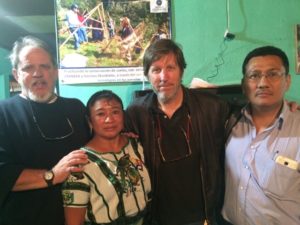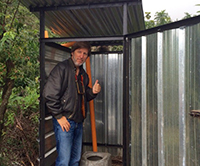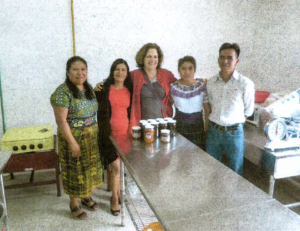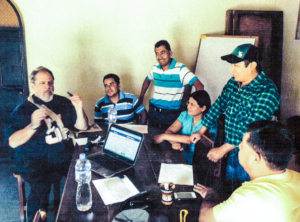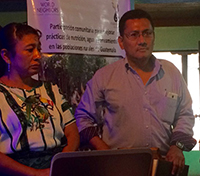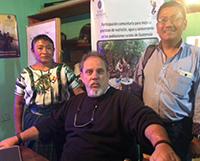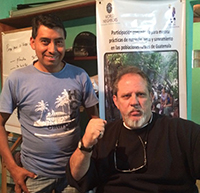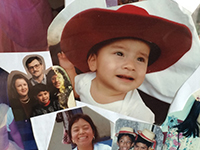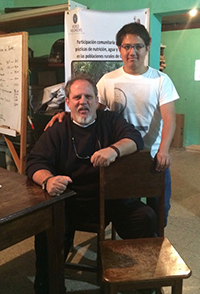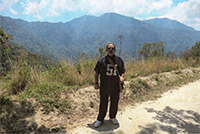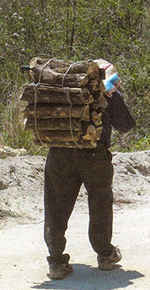


Guatemala
The Land of the Maya
The times-they are a-changing in Guatemala. Most notably, in the capital city, there are a truly significant number of high-rise office buildings and tall apartment buildings that have sprung up, mixed in with a plethora of restaurant chains, U.S.-style retail complexes, and international hotels. Add to that, much-improved roads, underpasses, and a very modern airport, and Guatemala City looks and feels quite different from decades past.
Yet, the cultural and colorful Mayan influence is still strongly felt and seen in many places, particularly as one leaves the capital city and gets immersed in the beautiful countryside scenery. A number of Mayan languages are still spoken today in rural areas. For World Neighbors staff member Pablo, his first language was Cakchiquel, and at about age six he began to learn Spanish. Today, he said, learning begins with both the native Mayan language and Spanish.
The remote areas where we work mark a clear contrast with the modernity seen elsewhere. Yes, there are roads, but they are of dirt and rock, still require four-wheel drive vehicles, and are sometimes utterly impassable in the rainy season. Many of the people don’t actually live by a road, but rather along narrow mountain paths. Most need to walk long distances to retrieve their daily water and then lack drinking filters to prevent disease. For many, electricity hasn’t reached their homes, and at best, their sanitation is an outhouse.
In the Chortf region to the east, far from the signs of modern life, a women’s savings and credit program was formed less than a year ago with the help of World Neighbors. They are now assessing how they can make a larger profit from their hammock making, which nets them about $1.25 U.S. per full day of work. They say that while everyone wants discounts on their hammocks, when they go to buy corn or beans during the dry season, the prices are fixed.
Way up in the mountains beyond Lake Atitlan, 250 inhabitants now have clean running water from mountain springs. The network of pipes, which they built themselves, is linked with holding tanks and a chlorine filter to deliver clean water. This new accessibility to water marks a true transformation in their lives. They provided all the labor, starting at a source far above them, and then built a separate holding tank along the way and the housing to hold the water filter. They dug the paths for underground pipes and strung the airborne portions. Thanks to financial assistance from the Rotary Club and engineering guidance from the local municipality, World Neighbors coordinated this important project with the community.
Based on our farmer-to-farmer approach, one of the young men there, Alberto, received special training that he is now replicating on his family’s small acreage. In addition to contour farming on steep slopes, use of green manure, and diversification of crops, including vegetables and irrigation, he has set up a system to capture cow, goat, and chicken dung and urine. This improves the fertility of the land, and extra amounts can be sold. This model approach allows his neighbors to observe and, in turn, replicate his significant results.
In San Lucas Taliman near the shores of Lake Atitlan, we are partnering with what is becoming a dynamic organization, CPANESA. They have a store and a commercial kitchen where jams, jellies, marmalades, and chilies from home gardens are prepared and sold in jars, along with bakery goods they produce. The store and kitchen employ two shifts per day, and members are also actively involved in sales.
It can’t be emphasized enough how profoundly impoverished the people are in areas where we work and, for that matter, in the towns as well. If there were nothing that could be done, that would be one very sad matter. If throwing a lot of well-intentioned money could change their world for the better, that would be another matter. But World Neighbors continues to find our low-cost, hand-up approach a great path forward. With World Neighbors creating the spark, providing the training, and working alongside communities through initial successes and a progression of internal growth achievements, the people themselves become their own problem solvers and doers. Much still needs to be done, and that is an understatement.
Not far from the border with Honduras, a group of 1,700 has formed the Asociaci6n de Mujeres Olopenses (AMO). They weave baskets and purses, and make shoes-all with maguey, a natural fiber from the Agave family. They also work with seven varieties of native corn and bean seeds, including Bejuco, Chiquimulteco and Villano. The aim is to rescue native seeds of grains (maize and beans) that are part of the staple diet of families in Guatemala, as well as to provide an added source of income for the member growers. They sell these certified seeds from their seed bank maintained in the town of Olopa. Health, nutrition, and sanitation, along with savings and credit, are additional key themes they are working on through their collaboration with World Neighbors.
Though much has changed in Guatemala in recent decades, much still needs to be done-particularly to lend a hand-up to our distant neighbors in the more remote parts of the land of the Maya.
Courtesy World Neighbors


